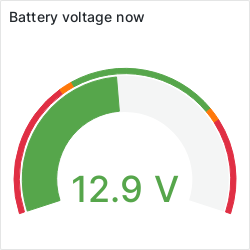So, late yesterday afternoon, I devised a light test of the controller to see how it would perform.
For this I disconnected all but one of the nodes, and hooked up one of my old 10Ah LiFePO₄ packs and my 3A charger hooked to mains. The LM2576-based charger is just able to hold this load and provide 1A charging current.
The first thing I noticed is that the fan seemed to turn on and off a lot… this could be a difference in the temperature sensors between the DIP version of the ATTiny24A that the prototype used and the SOIC version which the new controller used.
The test ran overnight. The node basically was idling, as were the two Ethernet switches. But, it served the purpose. I now know the logic is sound, although I might want to adjust my set-points a little.
That’s the output data from a small digital power meter that was hooked up in circuit. This device is unable to display negative current, so the points at which the battery was charging is shown as 0A. Left axis is voltage, right is current. You can see that the charger gets brought in when the battery dips below 12V and clicks off just before 13.2V.
I can probably go a little higher than that, maybe about 13.6V. I may also need to re-visit the fixed resistor settings on the linear regs inside the nodes to knock them down a few more pegs to prevent the BMCs whining about the high voltage.
Next weekend, I might consider hooking up the 20A mains charger and giving it a full load test.




Recent Comments